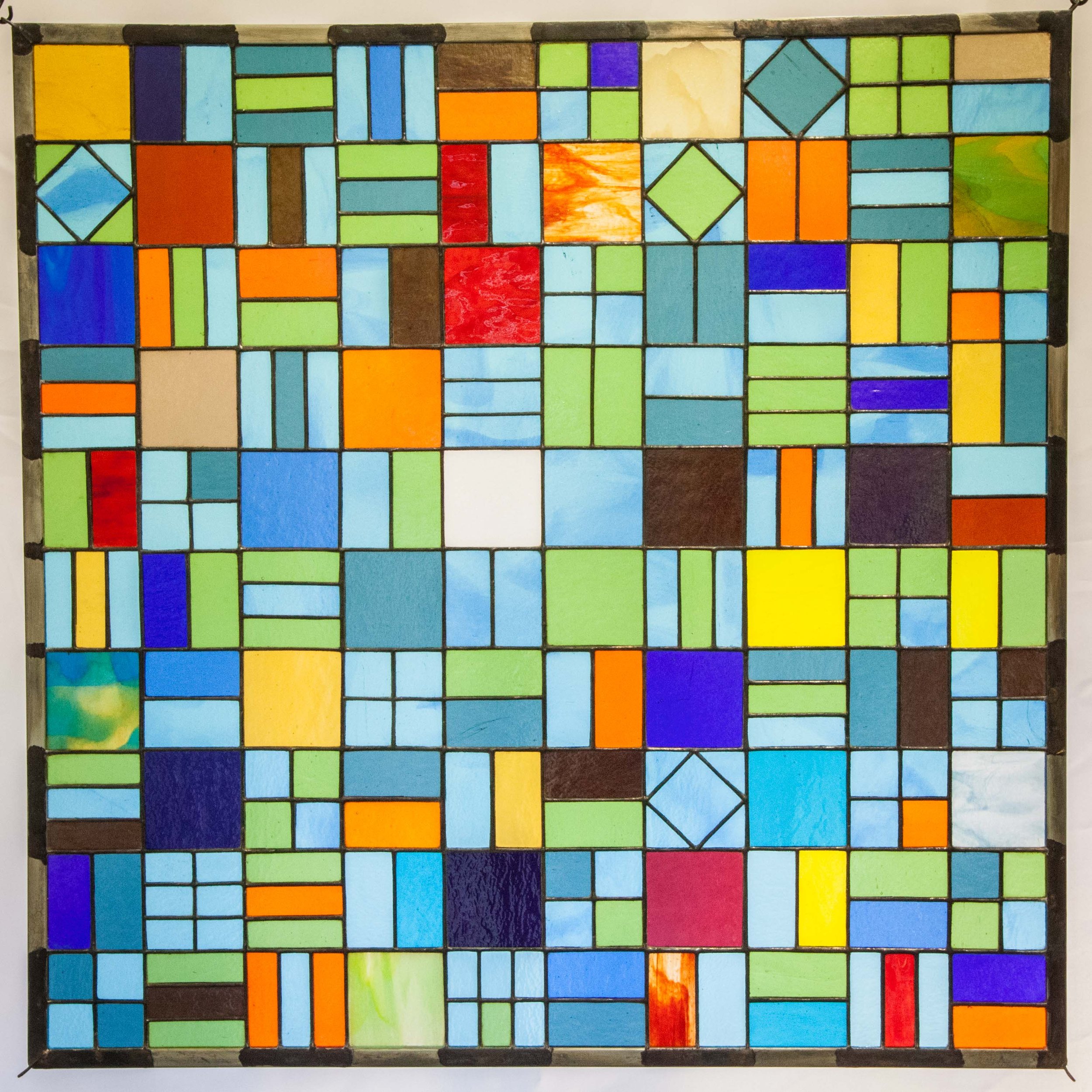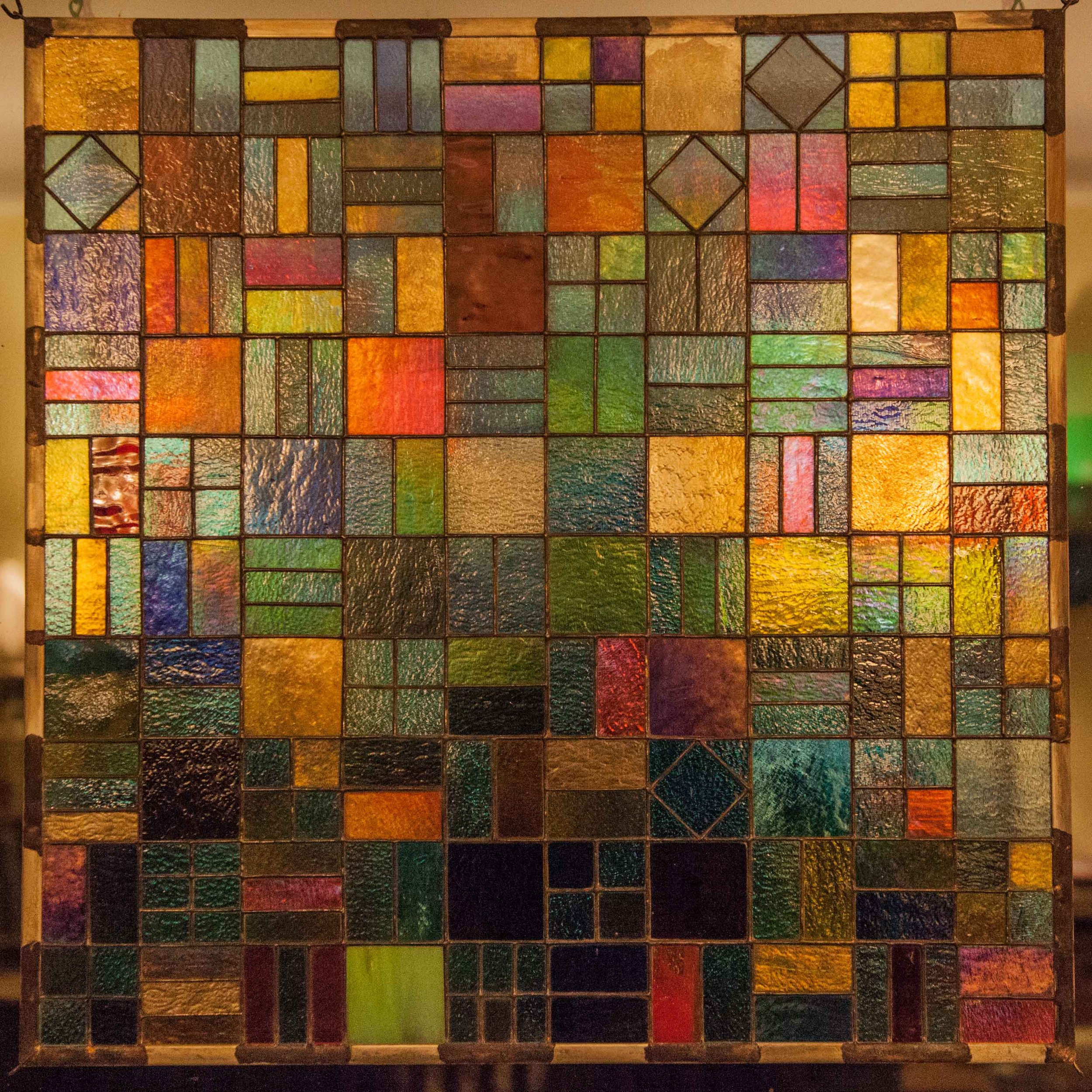The Puzzle of Eratosthenes In Ulam’s Garden
Eratosthenes in Ulam’s Garden in transmitted light. 20″ x 20″
Sometimes an idea takes lots of research and work, tons of deep thinking, false starts. Other times the Muse leaves a gift in her wake. Eratosthenes in Ulam’s Garden is an example of the latter case.
The first weekend of the Portland Open Studios tour was incredibly fun, exciting, and wonderful all around. It was also a massive expenditure of energy, including some physically demanding work the week before; getting the studio presentable and finishing up the Golden Primes piece.
Monday morning I was pooped. Utterly. I was groaning about how much effort it was going to take to get my butt off the couch, to which my husband suggested I take the next couple days off. So I settled my butt deeper in the couch, perused the web, read a book, and listened to an audio book when my eyes politely suggested they’d prefer to be closed.
Somehow by the time I got my charge back the next evening, I found I had an idea for a piece which felt like it had erupted from my head fully formed, Athena-like. Nothing I’d read, watched, or listened to over the course of the days off had anything to do with mathematics. I have no idea what the seed for it was, I simply found myself excited to get started on it.
The background for this piece comes from a couple of mathematical ideas.
Eratosthenes’ Sieve is a way of finding Prime numbers through brute force, iteratively crossing off all the multiples of the Primes. This sieve, and others like it, are used by computers to find very large Prime numbers because there is no predictive formula for locating them. They appear randomly scattered along the numberline.
Every positive whole number greater than 1 is either Prime or Composite. Prime numbers are divisible only by themselves and one, while Composite numbers are made up of Prime number factors. Two is a Prime number; each multiple of two must be Composite.
The next number that isn’t a multiple of 2 is 3, so it’s Prime, and all multiples of that are Composite. Four is Composite, 2 x 2. Five is not a multiple of either of the previous Primes so it must also be Prime. Six is a multiple of both 2 and 3, Composite. Seven is not a multiple of previous Primes so it’s a Prime … etc.
Ulam’s Spiral started as a doodle by mathematician Stanislaw Ulam while sitting through another mathematician’s talk at a conference in the 60’s. He started by wrapping the number line around itself. Then he applied Eratosthenes’ Sieve to it, and was startled to see a secondary spiral pattern emerging. That’s odd because because of the absence of a predictive pattern for Primes.
Somehow these three ideas, the Sieve, the Spiral, and the Prime/Composite nature of positive whole numbers came together and gave me a vision of what I wanted to make. I sat down and made a list of the numbers from 1 to 100 and mapped out the Primes and the Prime factors of the composites. I fiddled around with how to represent composite numbers and decided that dividing each square in the 10 x 10 grid into smaller squares, rectangles, and the occasional triangle would work well.
Eratosthenes in Ulam’s Garden in reflected light
Since One is not considered a Prime number it is represented by a clear square which is not repeated. Every Prime number has it’s own color for the whole square. Each Composite number is made up of the colors of the Primes that go into it. Two is blue, 3 is green, 5 is dark teal, 7 is a bright orange with an iridescent coating, etc. Four is represented by 2 blue rectangles, 6 by 1 blue and 1 green, 9 by 2 green and so forth.
If you know what color each Prime is, then you can figure out what the number is of any square. That square with the blue, green, and orange rectangles is 2 x 3 x 7, or 42. The one with 2 blue triangles, 2 green ones, and a blue square tipped on its point is 2 x 2 x 2 x 3 x 3, or 72. The square with 1 red and 1 green rectangle is 3 x 23, 69.
After I started working on it, I got curious about the background behind Ulam’s Spiral. I knew what it was, but not its origin. I found several brief discussions of it, all saying essentially what I’ve restated above. Then I discovered an article which goes into detail about why the secondary spiral is a figment of the nature of the sieve.
I’ve always been fascinated by the way our minds find meaning in random noise. We see faces in the leaves or bark of a tree, see a pattern to our favorite team winning when we wear a certain pair of socks, notice good things happening when we’re carrying that rabbit’s foot, etc. The recognition of that tendency is important for critical thinking and avoiding biases.
For me, the secondary spiral has always had a slightly fae quality to it, it must mean something, right? It must be a sign of some way of predicting Primes we haven’t found yet! The pattern is so clear, if a bit erratic. Reading the article and seeing how that pattern emerges as an artifact of the multiples of two beginning the sieve process was one of those electrifying moments for me. That feeling, the sense of discovery, is what I love about math, science, philosophy, art, music … learning.
Aside from the story of its creation, Eratosthenes in Ulam’s Garden was a technically challenging piece, at least on par with the Planeta works. Like those it has many small pieces that have to line up well or become a jumble. Unlike those, deviations of less than a millimeter are quite noticeable and add up across the width of the piece. This is a level of precision I haven’t had to achieve before. I’ve learned a couple things about how to approach it skillfully that I look forward to putting into practice in future work.
I hope you enjoy the story of the piece as much as I enjoyed discovering it.
All the best,
Claire

